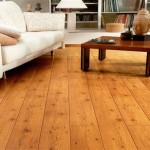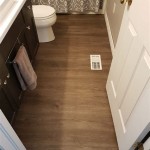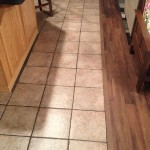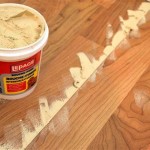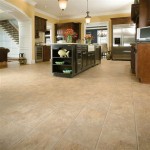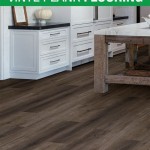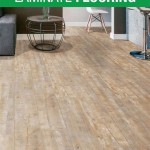How To Remove Marks From Laminate Flooring
Laminate flooring offers an attractive and durable surface for many homes and businesses. Its ability to mimic the look of hardwood, tile, or stone at a more affordable price point makes it a popular choice. However, like all flooring materials, laminate is susceptible to marks and stains. Understanding how to effectively remove these marks without damaging the flooring's protective layer is essential for maintaining its appearance and longevity.
The approach to removing marks from laminate flooring varies depending on the type of mark present. Common culprits include scuff marks from shoes, stains from spills, sticky residue from adhesives, and discoloration from certain materials. Using the correct cleaning methods and products is crucial to prevent further damage such as scratching, dulling the finish, or causing the laminate to swell.
Identifying the Type of Mark and Appropriate Cleaning Supplies
Before attempting to remove any mark, it's important to accurately identify its nature. This will dictate the most effective cleaning method. For instance, a simple scuff mark might require only a soft cloth, while a more stubborn stain may necessitate a specialized cleaning solution. Similarly, understanding the composition of the laminate flooring itself is vital. Some laminate floors are more sensitive to certain cleaning agents than others. Consulting the manufacturer’s guidelines for cleaning and maintenance is always recommended.
Common types of marks encountered on laminate flooring include:
*Scuff Marks:
These are surface marks typically caused by shoes, furniture, or other objects rubbing against the flooring. They often appear as dark lines or streaks on the surface. *Stains:
Stains can result from spills such as wine, juice, coffee, or pet accidents. The longer a spill remains on the floor, the more difficult it becomes to remove the stain. *Sticky Residue:
Adhesive residue from stickers, tape, or other materials can be particularly challenging to remove. *Grease and Oil:
Kitchen spills involving grease or oil can leave unsightly marks on laminate flooring. *Heel Marks:
These dark, rubbery marks are often caused by shoes with rubber heels.Once the type of mark has been identified, the appropriate cleaning supplies can be gathered. Essential supplies generally include:
*Soft Cloths or Microfiber Mops:
These are preferred for gentle cleaning and preventing scratches. *Warm Water:
Often the first step in cleaning, warm water can dissolve many surface marks. *Mild Dish Soap:
A small amount of mild dish soap can be added to warm water to create a gentle cleaning solution. *Isopropyl Alcohol (Rubbing Alcohol):
Effective for removing stubborn stains and sticky residue. *Acetone (Nail Polish Remover):
Can be used sparingly for extremely difficult stains, but should be tested in an inconspicuous area first. *Baking Soda:
A mild abrasive that can help remove scuff marks and stains. *White Vinegar:
Can be diluted with water to create a natural cleaning solution. *Laminate Floor Cleaner:
Commercially available cleaners specifically formulated for laminate flooring. *Soft-Bristled Brush:
Useful for scrubbing stubborn marks, but avoid using abrasive brushes that could scratch the floor.Always test any cleaning solution in an inconspicuous area of the floor before applying it to the entire mark. This ensures that the solution doesn't damage or discolor the laminate.
Specific Techniques for Removing Different Types of Marks
Different types of marks require specific cleaning techniques to ensure effective removal without damaging the laminate flooring. Applying the wrong technique can worsen the problem or even cause permanent damage.
Removing Scuff Marks:
For light scuff marks, simply rubbing the area with a clean, dry cloth may be sufficient. For more stubborn scuff marks, try the following methods:
1.Pencil Eraser:
A clean pencil eraser can be gently rubbed over the scuff mark to lift it away. 2.Baking Soda Paste:
Mix a small amount of baking soda with water to create a paste. Apply the paste to the scuff mark and gently rub with a soft cloth. Wipe away the paste with a damp cloth and dry thoroughly. 3.Tennis Ball:
Rubbing a clean tennis ball over the scuff mark can often remove it without damaging the floor.Removing Stains:
The key to stain removal is to act quickly. The longer a stain sits, the more difficult it becomes to remove. Blot up any excess liquid immediately with a clean cloth. Then, try the following methods:
1.Warm Water and Mild Dish Soap:
Mix a small amount of mild dish soap with warm water. Dampen a soft cloth with the solution and gently rub the stain. Rinse with a clean, damp cloth and dry thoroughly. 2.White Vinegar Solution:
Mix equal parts white vinegar and water. Apply the solution to the stain and let it sit for a few minutes. Wipe away the solution with a clean cloth and dry thoroughly. 3.Isopropyl Alcohol:
Dampen a cloth with isopropyl alcohol and gently rub the stain. Rinse with a clean, damp cloth and dry thoroughly. This is particularly effective for ink and dye stains. 4.Laminate Floor Cleaner:
Follow the manufacturer's instructions for applying laminate floor cleaner to the stain.Removing Sticky Residue:
Sticky residue can be particularly stubborn. These methods usually work:
1.Warm Water and Dish Soap:
Often, warm soapy water can soften the adhesive enough to be wiped away. 2.Isopropyl Alcohol:
Isopropyl alcohol is often effective at dissolving adhesive residue. Apply a small amount to a cloth and gently rub the residue. 3.Acetone (Nail Polish Remover):
Use acetone cautiously and only on small areas. Apply a small amount to a cloth and gently dab the residue. Be sure to rinse the area thoroughly with water afterward, as acetone can damage some laminate finishes. 4.Ice Cube:
Holding an ice cube on the residue for a few minutes can harden it, making it easier to scrape away with a plastic scraper.Removing Grease and Oil:
Grease and oil spills require immediate attention to prevent them from penetrating the laminate flooring. Some solutions include:
1.Blotting:
Immediately blot up as much grease or oil as possible with a clean paper towel. 2.Dish Soap and Water:
Create a solution of warm water and dish soap. Apply it to the spill, let it sit a few minutes, then wipe clean. 3.Baking Soda:
Sprinkle baking soda over the grease spot. Allow it to sit for several hours, then vacuum up the baking soda.Removing Heel Marks:
Heel marks from shoes are also removable via these methods:
1.Pencil Eraser:
Similar to scuff marks, a clean pencil eraser will sometimes remove heel marks. 2.Baking Soda Paste:
Make a paste of baking soda and water. Apply it to the mark, rub gently, and wipe away.Preventative Measures and Long-Term Maintenance
Preventing marks from occurring in the first place is always preferable to removing them. Implementing preventative measures and establishing a regular cleaning routine can significantly extend the life and appearance of laminate flooring.
Here are some preventative measures to consider:
*Use Doormats:
Place doormats at all entrances to trap dirt, debris, and moisture before they are tracked onto the laminate flooring. *Use Rugs in High-Traffic Areas:
Place rugs in high-traffic areas such as hallways and living rooms to protect the flooring from wear and tear. *Use Furniture Pads:
Attach furniture pads to the legs of chairs, tables, and other furniture to prevent scratches and scuff marks. *Avoid Wearing Shoes Indoors:
Encouraging household members and guests to remove their shoes can significantly reduce the amount of dirt and debris that is tracked onto the flooring. *Clean Spills Immediately:
Addressing spills as soon as they occur prevents staining and reduces the risk of permanent damage. *Regular Sweeping or Vacuuming:
Regularly sweep or vacuum the floor to remove dirt, dust, and debris. Use a vacuum cleaner with a soft brush attachment to avoid scratching the laminate. *Avoid Excessive Moisture:
Laminate flooring is susceptible to water damage. Avoid using excessive amounts of water when cleaning the floor and always dry it thoroughly after cleaning. *Use Appropriate Cleaning Products:
Only use cleaning products specifically formulated for laminate flooring. Avoid using abrasive cleaners, scouring pads, or steam cleaners, as these can damage the flooring's protective layer.Regular cleaning is essential for maintaining the appearance and longevity of laminate flooring. A general cleaning routine should include:
*Daily Sweeping or Vacuuming:
To remove loose dirt and debris. *Weekly Damp Mopping:
Using a laminate floor cleaner and a damp microfiber mop. Avoid oversaturating the floor with water. *Spot Cleaning:
Addressing spills and marks as soon as they occur.By implementing these preventative measures and establishing a regular cleaning routine, it is possible to keep laminate flooring looking its best for many years. Proper care and maintenance will reduce the need for aggressive cleaning methods and prolong the life of the flooring.

8 Ways To Fix Scratches On A Laminate Floor Mersey Flooring

How To Fix Scratches On Laminate Flooring Directflooring Direct

Removing Stains On Your Laminate Flooring

How To Remove Pesky Scuff Marks From Laminate Flooring

How To Remove Scuff Marks From Laminate Flooring Liquidators

Some Simple Tricks To Remove Stains From Laminate Flooring

How To Handle And Remove Stains From Laminate Flooring Singapore

How To Remove Stubborn Stains From Laminate Flooring

How To Remove Scuff Marks From Your Floor Maggy Maid

How To Clean Laminate Floors Tools And Guide
Related Posts


